Reflecta film scanner RPS 7200 Professional
At the beginning of the year 2005 Reflecta placed the RPS 7200 on the market - as the follow-up model to the RPS 3600. If the two devices are compared side by side, some differences in colour can be seen, but the rest appears as two times the same device with the same, salient casing - a shape, which is unusual for a film scanner. Yes, the RPS 7200 differs from all other film scanners due to its fancy shape. With its four, broad stands and the sight-window at the front, the RPS7200 Professional reminds of a small, funny vehicle with four wheels and a windshield. Such a design naturally brings life onto the desk of the everyday computer life.
The Reflecta RPS 7200 was replaced by its successor Reflecta RPS 10M at the end of 2014. Internally the Reflecta RPS 7200 Professional has changed in comparison to its predecessor model in one substantial point: The nominal resolution was doubled from 3600 dpi to 7200 dpi. With this resolution, scanned image files with more than 70 million pixels are possible; that's of course a sensational value. No 35mm slide or negative has such a fine resolution on the film layer; meaning the scanner scans with a far higher resolution, than physical information is present on the film. Our resolution test further down on this page will show, what resolution of the nominal 7200 dpi is effectively remaining.
Another change to the predecessor model is the ICE dust and scratch correction, as well as two further correction procedures: GEM film grain smoothing and ROC color restoration. Last but not least the SCSI port was replaced with a Firewire connection, so the RPS 7200 can be attached to the computer using the usual interfaces USB and Firewire. Since 2007 there's no longer a Firewire port, leaving just the USB connector.
Equipment, accessories and technical facts of the film scanner
The Reflecta RPS 7200 Professional is a film scanner, which can only scan 35mm film material. This material can be present either in the form of framed slides or in the form of film strips. Framed 35mm slides (positives or negatives) have to be inserted into the slot at the front of the scanner and taken out after scanning. For 35mm filmstrips (likewise positives or negatives) the scanner has an automatic film strip feed: the film strip needs to be inserted laterally into a small opening slot and the device will pull in the strip automatically. While framed 35mm slides must be individually scanned piece by piece; scanning of film strips is possible in batch mode, meaning the scanner can process whole filmstrip automatically by moving the strip forward picture by picture and scanning each picture individually. I think it's remarkable that the RPS 7200 can not only process small film strips, but also whole film rolls up to a length of 40 pictures - a great plus from my side for this feature! In this point it leaves a lot of the competing models behind it, which can take either only film strips up to a length of 6 pictures, or require awfully expensive special accessories in order to be able to process film rolls.
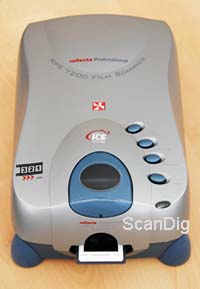
The RPS 7200 Professional has a sensational optical resolution of 7200 dpi. This allows to obtain 10000 x 7000 pixels from a small picture with the dimensions 36 x 24 mm, which means one receives 70 megapixel scans in highest resolution. Such scans take more than 200 megabytes on the harddisk if saved in a non-compressed TIF-format, and even more than 400 megabytes in 48-bit mode. An older computer with little main memory would have somewhat trouble handling the post-processing of such a file. Whether scans with such a mega-resolution make sense, will be discussed further down on this page. Nevertheless it must be mentioned that the RPS 7200 sets the top mark with it's nominal resolution of 7200dpi.
The scanner has a maximum density of 3,6. This allows to assume that it has a density range in the magnitude 3. For most cases this is sufficient; for extremely dark pictures (e.g. stars) or very bright pictures there might be however problems in the color graduations. The color depth (for an explanation please see on our page on color depth) is adjustable to 24 bits or alternatively 48 bits. 24 bits means 8 bits for each color channel (red, green, blue) thus in each case 256 colors per basic colour. Altogether 24 bits depth can theoretically provide up to 16 million of different colours. Scanning with 48 bits depth makes the image files twice as large and one can theoretically receive over 280 trillion different colours.
A special feature of the Reflecta RPS-7200 Professional is in my opinion the front window, where one has a direct view of the inserted picture. For both - a beginner and for an experienced person like me, it's interesting to watch the film scanner do it's work; to see how the lamp in tiniest steps scans the slide. For the advanced user the front window serves for accurate positioning of a picture on a film strip. It's immediately visible whether the picture is placed correctly - not just only through the preview in the scanning software. Afterwards a film strip can be positioned by using forward- and backward keys. This small front window is really unique in the filmscanner scene and receives upfront a huge praise from me.
The scanner is attached through an USB-cable to the computer (PC or Mac). Cables are contained in the box. A 22-pages manual in the languages German, English, French, Netherlands, Portuguese, Spanish and Italian is also supplied. The RPS 7200 is available either with the reflecta-own software CyberView or with SilverFast AI. Upfront: In my opinion it makes no sense to use CyberView for this scanner; it unfolds the strengths only with SilverFast AI and it's IT-8 color calibration. Furthermore Adobe® Photoshop® Elements version 2 is included in the box, which gives the user user a very good image-processing program for the treatment of the scans after digitalization.
Setup, Installation and starting
Compared to some other film scanners, the Reflecta RPS 7200 Professional is packed in a relatively small, lightweight cardboard box. Indeed the scanner measures only 183 x 97 x 274 mm (width x height x depth) and weighs just 1,5 kg. Since one inserts framed slides directly at the front into the scanner and laterally feeds film strips, one does not need separate film-holders or adapters for the different film types. Only the scanner is on the desk, nothing else is needed. This saves space, both on the desk and in the cardboard-box, therefore the small size and the lightweightness.
To me the installation went quite easily; it is important to first install the scan software - then connect the scanner to the computer and switch it on. Whoever runs the scanner with CyberView, installs the software from the included CyberView CD; after a certain time the software gives the signal that one may now attach the scanner and switch it on. If running the device with SilverFast it is not necessary to install CyberView first, because SilverFast is scan software and scanner driver in one. After the installation of SilverFast, the associated license-key must be entered, then the scanner is ready for use.
So the installation goes extremely simple and fast - nevertheless each 20th customer calls us to say the scanner doesn't give even the slightest signs of "life". This is due to a small, unobtrusive switch on the backside of the device. With this switch one has to manually set whether the scanner is connected through an USB or IEEE-1394 (Firewire) interface. If that switch is in the wrong position, the film scanner indeed doesn't communicate with the computer at all and is playing dead. Since 2007 the switch and the Firewire interface don't exist any longer, so this problem is finally gone.
Scanning framed slides
With the Reflecta RPS 7200 Professional, one can digitize framed slides in a very simple way. One must neither worry about the kind of frame nor about any film holders, because a framed slide has to be simply inserted into a rounded slot at the front of the scanner and the scanning can start. The slot is locked if no slide is inserted; it opens according to the thickness of the slide's frame. This way all kinds of slides can be inserted in the RPS 7200, from extremely thin plastic frames over cardboard frames to extremely thick glass frames.
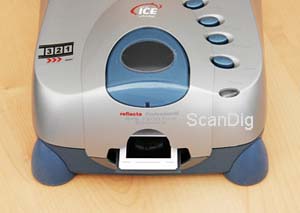
With the RPS 7200 the user can always just insert only one slide at the time, so there's no need for an index scan. One makes a pre-scan and (after adjusting all attributes) the fine-scan. In both procedures I consider it once more interesting to observe the function of the scanner through the sight window. In SilverFast the preview picture develops during the pre-scan line by line, which I consider pleasant because through this visible progress, after a certain time first parts of the picture can already be inspected.
While the standard scan software Cyberview offers only basic picture adjustment possibilities, SilverFast will provide an enormous number of adjustment possibilities within it's toolset. The adjustment of lights, depths and the mid-tones can be performed by selecting given motive-choices such as landscapes or skin colors; using automatic adjustment or manually through different controllers (tone values, graduation curves, stencils). Thus SilverFast offers simple tools for the average user and complex tools for the professional user.
With the job pilot or stored jobs, the scan job can be automated, however in each case just for the one inserted picture. One notices fastly that the RPS 7200 Professional was not built to digitize large numbers of 35mm slides. It is rather a photo scanner made to quickly insert one slide and scan it.
| Procedure |
Duration |
| Preview one framed 35mm slide |
0:24 min |
| Scan one framed 35mm slide with 7200 dpi, ICE off, IT8 on |
3:45 min |
| Scan one framed 35mm slide with 7200 dpi, ICE on, IT8 on |
2:35 min |
The scan times listed in the table above have been achieved on a computer with 3,2 GHz processor and 2 gigabyte main storage; the scanner was connected through an USB 2.0 interface and used with the SilverFast scan software. One recognizes that the preview time is amazingly small. Also the scanning time of two and a half minutes for a maximum resolution 7200 dpi scan, with enabled dust and scratch correction, is remarkable. That's why the RPS 7200 can be called a fast device, when it comes to scanning of framed 35mm slides.
The scanning time is substantially longer, if the scanner is being operated by SilverFast without dust and scratch correction. This is a strange thing and I have to emphasize that I didn't switch the numbers by mistake - I could reproduce this effect several times. This makes the RPS 7200 the first scanner, which takes more scanning time without ICE, than with it. This effect is really unexplainable to me; but it can naturally be evaluated positive, because one usually scans with automatic dust correction.
The scanning time increases quite a bit, if additional filters of the scan software are being used. If the GEM film grain suppression, the ROC color restoration and other correction filters are switched on, a doubling of the scanningtime can easily happen.
Scanning film strips
While scanning framed slides with the Reflecta RPS 7200 Professional is rather difficult work since one individually inserts and scans each slide, the RPS 7200 shows its true strength when it comes to film strips. As it is the case for framed slides, no additional holder is necessary for negative strips either. Film strips are placed into the scanner at the left front side through a small slot and are drawn-in automatically.
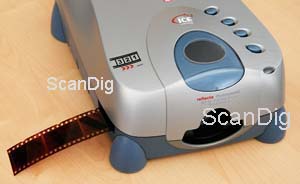
As soon as a negative or a positive strip is loaded, the exact positioning in the film scanner can be seen through the upper window - I can only praise the sight window on the upside again and again. The fine adjustment of the strip (to ensure it's placed correctly) can be done by using the back- and forth keys. On the right side of the negative scanner is a further slot, where the strip exits. Pressing the back- and forth keys shortly, transports the film strip in tiny steps; if one pushes the keys longer, then the strip moves one picture back or forth.
A film strip is inserted horizontally into the film scanner and it also exits horizontally. This has the advantage that the film strip doesn't have to be bent, it just needs to be moved horizontally. This becomes especially an advantage when the negative is slightly deformed and isn't completely straight anymore. Inserting into the left slot works nevertheless fine.
Naturally this construction has the advantage that a negative strip can be very comfortably inserted into the scanner without being in need of a filmstrip holder or templates. As disatvantage the rolling transportation becomes unfavourable when handling extremely high quality film material, which one would preferrably only touch with special gloves and tweezers. One has to hand over the filmstrips to the film scanner in hope that nothing will happen. Indeed I could not detect impairments to the inserted films. In order to prevent damaging the film strips when inserting them, I absolutely recommend to wear cotton gloves, because then the negative strip can be touched without leaving fingerprints or scratches.
The actual scanning of a negative or a positive works as usual: first an index scan has to be accomplished, which one could do well without too since the current picture can also always be seen direct through the scanner's glass sight. What follows is a pre-scan and then, after the adjustments are defined, the main scan.
Especially with film strips it makes sense to scan the whole strip at once and not just a single picture. SilverFast's job-manager is perfectly suited for such tasks. It's best to make all adjustments for a sample negative, store them in a job and start further scans simply by applying this job. This way a complete negative film can be scanned by inserting the negative strip a few times and just repeating the stored job. Individual scans are being automatically numbered by SilverFast.
| Procedure |
Duration |
| Preview of one picture |
1:45 min |
| Scan one negative with 7200 dpi, ICE off |
3:50 min |
| Scan one negative with 7200 dpi, ICE on |
4:45 min |
The scanning times indicated in the table above have been achieved on a computer with 3,2 GHz processor and 2 gigabyte main storage; the scanner was connected through an USB 2.0 interface and run with the SilverFast scan software. The scanning times are far longer compared to scanning positives, which is nothing unusual since that is the case with all film-scanners.
The scanning time increases quite a bit, if additional filters of the scan software are being used. If the GEM film grain suppression, the ROC color restoration and other correction filters are switched on, a doubling of the scan time can easily occure. The table shows that it's possible to drink a nice cup of coffee, while the scanner is busy on it's own with a filmstrip in the batch mode.
Scanning film rolls
Only few film scanners can digitize whole 35mm film rolls. The Reflecta Professional RPS 7200 can take a whole film roll and even scan it in a batch, and this even completely without need for additional accessories - in my opinion a very praiseworthy characteristic - especially if one considers that for the big Nikon a special adapter charges more than what the Reflecta RPS costs. One can also insert the starting piece of the filmroll into the left slot (where one inserts filmstrips); the film exits just like the negative strip at the rightside opening of the slide scanner.
Film rolls have the uncomfortable characteristic that by definition they are bent and therefore deformed. The
Reflecta ProScan 4000 has tremendous problems when one tries to insert the film, since the film has to be pushed through an opening which has guiding rolls behind it. However - the Reflecta RPS 7200 has no such guiding rolls to bring a horizontally inserted film into a vertical position. Here the design and the construction of the film scanner become positively apparent: Film rolls are horizontally inserted exactly like negative strips, led across the sensor and made to exit again.
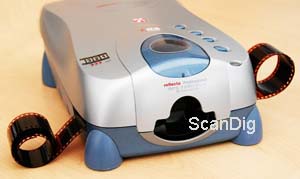
I'm not saying that inserting the starting part of a 35mm film roll into the film scanner is a children's game, but it works far easier than with the Reflecta ProScan 4000. With some sure instinct one can also bring a very deformed filmstrip between the guiding rolls inside the scanner. Once this is done, there are no more obstacles in the way to scanning an entire film in batch mode.
Once a film roll is inserted into the scanner, SilverFast as scan software can show what it has to offer with its possibilities for batch scans. One can produce both, an index scan and pre-scans of a whole filmroll at once. The fine scans can also be accomplished for a whole filmroll at the time. The scanning times are of course considerable if a film has 36 pictures. The film roll has to be cut precisely, meaning no empty pictures at the start or at the end are allowed; the exact positioning of the film can be done easily with the back- and forth keys at the scanner.
The RPS 7200 has however one problem in common with the Reflecta ProScan 4000: the film roll is neither somehow guided at the inlet nor at the outlet, meaning the parts of the film which have to be drawn-in or ejected are hanging loose alongside the scanner. Thanks to the horizontal construction of the device it cannot happen that the ejected ends automatically find their way back into the inlet of the scanner, but left and right from the filmscanner a boundless chaos can develop. With some luck the ejected part beautifully forms back to a roll; with bad luck the right end builds a knot or finds itself its own way. The disorder on the left and on the right side of the scanner is even bigger, when making an index-scan, since the entire film is fastly for- and backwarded then.
So I come to the conclusion, that having the possibility to scan entire film rolls is a praiseworthy and great extra-feature, but it's not suitable for digitizing larger amounts of filmrolls, since one can't let the scanner work on its own and must always keep an eye on the inlet and outlet.
Scanning single negatives or positives
Inserting a single framed slide or a negative strip into the RPS 7200 is not a problem at all and very simple. To scan single negatives or positives it is however necessary to take a different approach. Inserting a single negative into the filmstrip draw-in could lead to a massive chaos, since the picture might get stuck somewhere on the way.
There's no way to get past this without cutting the negative or positive correctly and to frame it like a positive slide. This is the same problem as with the Reflecta ProScan 4000, only there one receives already two spare slide frames with the scanner. Whoever has a lot of single pictures, will have a lot of work to do with the RPS 7200 Professional because the precise framing takes at least as much time as the actual scan.
Who never worked with slides before and has only film strips in the archive, should purchase a few slide frames for the shorter strip endings or single pictures - to scan them framed. For example reflecta cs-frames are recommendable for that.
Scanning APS-films
Even though the Reflecta RPS 7200 Professional can digitize whole film rolls at once, with APS cartridges one reaches the limits of the device. For other film scanners special APS film holders are available (for a surcharge), where complete APS film cartridges can be inserted. Since the RPS 7200 can work completely without frames and filmholders, such expansion possibilities aren't possible.
Even removing the APS film from the cartridge won't solve the problem, because the film format doesn't fit in the 35mm filmstrip guidance. There is no way to digitize APS films with the RPS 7200 Professional. Everyone should be aware of this fact before purchasing this device.
Included software
Reflecta delivers the RPS 7200 Professional in the simple version with a two part software package:
- Picture processing software Adobe® Photoshop® Elements 3
- Scan software CyberView
Alternatively to reflecta's own scan software CyberView it's possible to use the famous scan software SilverFast AI and the IT-8 calibration target. CyberView is a very simple scan software, which is very well suitable for beginners, since it's easy to use. However professional adjustment options for picture processing are missing, and the image quality which CyberView delivers, stays behind one's desires. Since the reflecta RPS 7200 Professional is not exactly a scanner in the low price segment, I absolutely recommend to run the scanner with SilverFast AI. Only then the device will yield an image quality, which is appropriate for the price.
The scan software SilverFast is very common and innumerable scanners (not only film scanners) are being standardly delivered with it; for most scanner types SilverFast is optionally available. SilverFast is not developed just for one device nor just one manufacturer; it's developed for an enormous group of scanners. Due to this one profits as user from any kind of progress. SilverFast has a solid basis of functions, which are the same for all scanners as well as an individual customization for the corresponding unique device.
For Reflecta, SilverFast is scan software and scanner driver at the same time, therefore no extra scanner driver is needed after the installation. SilverFast is not without reason the most common scan program: Prompting is intuitive and comfortable, the interface is clear and functional, the variety of functions is huge. The separation into standard functions and expert-dialogues is very good, so that a beginner is not hopelessly lost through an immense number of switches and controllers.
SilverFast has its strength in the automation of scanning procedures. An individual scan can be defined with the job-pilot into a firm pattern and batch-scans can be configured, stored and implemented with the job-manager. Some time is needed until one knows how to use all features. Praiseworthy is in SilverFast, that even a beginner can achieve the first good scan fastly and that for the expert there's nearly a limitless number of functions to explore. By the way, recently an outstanding book regarding SilverFast was published, which gives the beginner a great introduction into the world of scanning and of SilverFast and which describes the technical background of the expert dialogues to the professional.
SilverFast is started either as stand-alone program or through Photoshop®. It is of advantage to start SilverFast as independent application, because then it's possible to perform post-processing on already scanned pictures while other scans are in progress. The advantage if SilverFast starts through Photoshop® is, that the picture opens up in a new window inside of Photoshop® for further processing immediately after scanning.
In my opinion, Reflecta delivers the device with the best picture processing software on the market, which is Adobe® Photoshop® Elements. Of course the "Elements" version contains just a small fraction of functions when compared to a fully featured Photoshop® version; however the average user doesn't even use a fraction of the existing functions and filters in Photoshop® Elements, therefore the reduced version of the professional software still fully covers all needs. In any case one receives a very good program for further processing of the scanned pictures.
Image quality
The Reflecta RPS 7200 Professional comes strong with a nominal resolution of 7200 dpi and has thereby doubled the resolution in relation to its predecessor model. One can almost tell in advance that in practice there's not much remaining from this high value. In order to prove this, we do a resolution test with the help of an USAF testchart. The following illustration shows the internal range of the USAF-1951 scans.
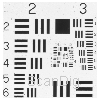
If we begin with the horizontal bars, then we notice that the three black bars of the element 6.2 can be just about abstracted from the bright background. The element 6.2 corresponds (according to the resolution table) to a resolution of 3650 dpi. With the vertical bars we can notice those of the element 6.2 still very clearly, while in element 6.3 we can hardly distinguish 3 bars from the dark color mixture; so the vertical resolution lies between the values for the element 6.2 (3650 dpi) and 6.3 (4100 dpi), thus it is approximately 3900 dpi.
If we combine both results, we get an effective resolution of approximately 3800 dpi. Considering the promised nominal resolution of 7200 dpi, this is a disappointing value, because the scanner in practice just reaches 53% of it. Such bad ratios one knows only from flatbed-scanners with a backlight unit and low-priced film scanners. An effective resolution of 3800 dpi is nevertheless an outstanding value for a film scanner: the scan of a 35mm slide produces effectively roughly 18 million pixels in maximum resolution, which is completely enough for a 35mm scan. Unfavourable is, that one gets giant image files which contain up to 50% redundant information; so one must scan every picture in highest resolution and then shrink it afterwards in Photoshop®. That's complicated and upsetting. I would prefer a scanner with 4000 dpi which delivers effectively 3800 dpi, since the image file would contain the genuine information and wouldn't be unnecessarily bloated.


Regarding the colour image quality of the Reflecta RPS 7200 Professional, one must clearly differentiate between working with CyberView and SilverFast. To cut a long story short: with CyberView the colors are not like desired and the scanner would get a bad judgement. That's a completely different story with SilverFast: an IT-8 color calibration target is included in the SilverFast-AI version to measure and calibrate scanners. SilverFast computes a color-correction-profile, which is then used automatically for every further scan. What kind of true miracles the IT-8 color calibration can make, is visible at the two scans of a landscape photo, which I attached here: the picture without IT-8 calibration calls indeed for a picture-processing treatment, while the picture with IT-8 color calibration offers shining colors with more contrast. The difference is like day and night. More such examples in highest resolution are available on our Demo-CD (see below), so one can convince himself, what substantial influence the IT-8 color calibration of SilverFast has on the image quality.
A similar difference is noticeable when scanning negatives: thanks to the NegaFix-dialogue of SilverFast, where one adjusts the brand and the type of film used for the negatives, SilverFast then creates an appropriate color profiles for the film and optimizes the picture. For negatives the comparison between SilverFast and CyberView is like day and night, too.
Seen in total, the RPS 7200 yields good pictures, if used with the SilverFast software. The fact that the scanner has its weakness in completely dark and completely bright picture portions, can be assumed already from its maximum density with 3.6; thus a density range of roughly 3.0. For most vacation pictures this density extent is completely sufficient.
Scanning speed
The Reflecta RPS 7200 Professional can be attached through USB to the computer. Whoever scans many pictures in highest resolution, shouldn't use an USB 1.1 link, since the low transfer speed can slow down the scanner very much.The times in the tables above increase considerably.
Looking at the scanning times in the tables above, one can notice that the RPS 7200 is rather a fast scanner in comparison to other film scanners. When comparing the times, one must consider that here the scanning is done with 7200 dpi and not with 4000 dpi or 3600 dpi, like with other devices. However, to be fair, it must be said that the 7200 dpi are effectively half as much worth, so actually the times can be compared with other, lower resolution scanners.
Even if the scan time for a slide appears to be acceptable, it seems like a small eternity, because one has to scan each slide individually, therefore beeing permanently in front of the computer and insert slide by slide. It's clearly more comfortable with film strips, because it is possible to enjoy a cup of coffee or relax in front of the TV while the scanner works on a negative film strip in batch mode,.
Summary, Result
The Reflecta RPS 7200 Professional is noticeable due to it's unusual design and brings life to the workplace at home. The device makes points through the possibility to scan slides and filmstrips and to digitize even whole filmrolls very easily. The image quality is very good if one operates the device with SilverFast software; with the CyberView software the quality of the scans is rather modest. The scanning speed is fine; the batch mode for film strips is remarkable. A nice extra is the sight window at the front of the scanner. The effective resolution of 3800 dpi is low, compared to the nominal resolution of 7200 dpi; but this value is nevertheless remarkable, since there is hardly another film scanner, even within higher priced devices, that offers such a high resolution.
Thus I come to the result, that I can recommend the Reflecta RPS 7200 Professional in connection with the SilverFast AI and/or SilverFast AI Studio software; however for the bare device with it's default CyberView software I can't give a recommendation.
Buying a film scanner
Please, feel free to visit our online shop - it's the only shop on the Internet which is fully specialized on film scanners and accessories! We can provide you with any film scanner at an extremely attractive price and we also can supply you with accessories such as film holders or optional adapters.
Back to the film scanner tests index
|